The post-pandemic world offers some hope to individuals and businesses on a global scale as we shift from crisis mode to recovery mode. Consumer mindsets and habits may have shifted long term as they carefully consider what products to buy and what services truly provide them with value.
In response to the way consumers have changed, how will you evolve your marketing strategy to meet the needs of your consumers?
The answer to that question will be different for every brand and business type as they begin to bounce back from the COVID-19 crisis. Let's review how you can change your marketing strategy for growth.
The 3 Parts of Any Marketing Strategy
A marketing strategy is a single comprehensive plan that includes all of a business’ marketing goals and objectives. Marketing executives generally draw information for their marketing strategies based on data collected from market research.
People often use the terms marketing tactics and marketing strategies interchangeably, but there is a difference – marketing tactics are the actions a business or marketing team takes to support a marketing strategy. To put it simply, a marketing strategy is the overall plan, and the tactics help you execute the plan.
Each marketing strategy is comprised of three parts:
1. Diagnosis
Before you begin developing a marketing strategy or plan, you need to understand your company’s obstacles and strategic position. During the diagnosis, you need to consider the environment, your resources, and the expectations of key stakeholders.
2. Course of Action
Based on your findings and evaluation from the diagnosis stage, you should be ready to select the best course of action for your strategy.
3. Strategy Implementation
The last part of developing your marketing strategy requires you to begin implementing your marketing tactics. The implementation of your strategy may take place in several stages as you carefully allocate resources to various marketing projects, like continuing to build quality links or publish helpful content consistently.
8 Important Marketing Strategy Tips to Consider in a Post-Pandemic World
COVID-19 impacted several businesses around the world and presented them with unique challenges throughout 2020. Business executives had to reorient their operations to keep their customers and employees safe while trying to keep their companies up and running.
The virus exposed the instability of many business models. And throughout the process of recovering, businesses have been forced to evolve their business models to continue operating.
It is possible to change your marketing strategy to grow your business in a post-pandemic world. Here are some tips and suggestions to help you evolve your marketing strategy:
Consider Your Brand’s Position in the Current Environment.
Making smart and strategic marketing decisions involves understanding what position your organization holds in the post-pandemic environment. Each business type has a different position.
Some businesses may have drastically slowed down while others’ growth may have accelerated. This causes each business type to face some strain as they try to position themselves in the market.
Ask yourself these questions to help you understand the position your company is in:
- What role do I play in the ecosystem?
- Who are my main competitors?
- Where am I headed?
- Can I regain the ground I lost during the pandemic?
- Who am I in my market?
Asking these questions helps you to analyze what you’re missing so you can start evolving your strategy for the new conditions you are facing in your business.
Focus on Making Decisions Quickly to Bounce Back.
Making decisions during and after a crisis may be difficult because of the uncertainty presented by the unique challenges that come with each crisis. It takes research and careful analysis to determine which direction you need to go in.
However, decision fatigue can slow your operations down further and be detrimental to your business.
Focus on making the best possible decisions with the information you have been given, and adjust your decisions according to the new information you receive later on.
Your marketing strategy may not be perfect by the time you implement it, but as you see how your consumers respond, you can adapt your marketing messages and materials.
Having a plan and making decisions based on that plan will help you to bounce back from the confusing situation you may be in.
Develop a New Marketing Activity Schedule or Adapt Your Current Schedule.
Are you ready to accomplish the marketing activity and projects you outlined before the pandemic? If you aren’t, then you should develop new marketing activities and schedule them according to your needs and objectives.
You should also check your automated marketing content to make sure the messages are relevant and appropriate. If they are appropriate, you may keep them on the schedule for release. If they aren’t, you may consider removing them and adding new content or messages to release to your target audience.
It is important to stay on track by keeping up with the marketing tactics that help you implement your strategy. To stay on track, prioritize the most important things first, track any changes you make in the schedule, and don’t delete anything.
Make sure to save any good ideas that may not be appropriate for the market following a crisis. As things return to normal, your good ideas are likely to help your consumers at some point.
Determine Where to Use Your Marketing Resources.
Evaluate your existing marketing channels and determine which ones are the most effective for your current marketing messages.
Your resources may be limited in the time following a crisis like a pandemic, and considering where to place your marketing resources is more important than ever.
You must use the most effective platforms that identify and connect with your audience to get them to take desired actions.
Conduct competitor analyses to see which marketing channels work best for your competitors and gather historical data from your past marketing campaigns to see which ones work best. You may also try to survey your current customers to see how they found out about your products or services to see if you can identify any trends.
Adapt the Four P's of Marketing to Your New Reality.
The four P's of marketing are as follows:
- Product
- Place
- Price
- Promotion
Since crises like the COVID-19 pandemic have changed the way people shop and consume goods, their behavior will likely continue to change in a post-pandemic world.
Consumers are more likely to carefully consider their options than before as they make conscious choices hoping that what they buy will provide them lasting value. This means you must adapt your four P's of marketing to your customers’ new reality.
Here are some things you may consider to help you adapt your four P's:
Product
It's important to continuously reflect on the experience your products or services provide for your customers and to evaluate ways that will change over time.
- Which features and benefits of my products or services are more or less valuable to consumers as they make deliberate choices after this crisis?
- Did the disruptions caused by the pandemic or other crisis permanently cause people to change what they need? For instance, as people become more focused on personal health and buying products with authentic ingredients, will this trend continue?
Place
Social media usage and online shopping have increased during the pandemic as people began to stay home more often. Some brands and retailers also offered consumers a curbside pickup option to allow their customers a quicker way to get what they want.
- Will consumers continue to use social media and online shopping as a primary tool for consumption?
Price
According to a pricing study conducted by Skim, price sensitivity remained about the same during the pandemic. However, there has been a shift toward bulk offerings and lower-tier brands.
- Are shoppers more concerned with the added benefits and efficacy of higher-end products, or are they more cautious when it comes to spending?
Considering this question will help you to decide your price points during and after pandemics and other major global crises as you consider how your target audience has been financially impacted by the crisis.
Promotion
It is important to consider where your consumers are in the buyer’s journey before you start new promotions.
Depending on where they are in their journey, your advertising and marketing messages my need to trigger action, reinforce brand loyalty, or repeat trial purchases.
The post-pandemic world will likely continue to hold uncertainties for consumers, and their behavior and beliefs may adjust daily. Ensure that your promotions adapt to those changes.
Think About Contribution Instead of Conversion.
Continue to offer value to your customers after the pandemic.
There is likely going to be a recovery period that requires people to think and act differently than they used to when things were normal. Cultivate compassion and reflect that compassion and care in your marketing messages.
Provide your audience with helpful resources that allow them to educate themselves for free. If your business is in a position to help individuals affected adversely by the pandemic, then develop marketing campaigns about your dedication to providing assistance to those people.
Your contribution to society will likely provide you with an increase in revenue and may attract new customers to your brand. When your brand strives to make a difference, prospects and customers strive to want to make a difference with you by supporting your organization.
Inspire Hope, But Don’t Overpromise.
It is important to stay positive and to provide your customers with a hopeful outlook. But it is also important to be realistic and only make promises you can keep.
The best way to do this in a post-pandemic environment is to focus your attention on what you can do rather than what you will do in the future.
Trying to keep up morale with empty promises is sure to backfire on you. This has been an unprecedented situation for everyone, and all you can promise your audience is that you will stay committed to helping them the best you can.
Modify Your Offers.
Adjust your offers to make sure they are relevant to the current market. Ensure that your marketing messages are flexible so you don’t have to continuously update them every time new information is available.
Update your offers to make sure they are socially responsible and reflect the safety measures, trends, and lifestyle changes associated with COVID-19.
Make your calls to action (CTAs) less urgent. For example, instead of “Book now before it’s too late!,” you may highlight affordable services and products, mention how “we are all in this together,” or let consumers know your top priority is their safety.
Ulta, a popular makeup store, adapted their calls to action on their website to display how much they care about their customers' safety while they shop.
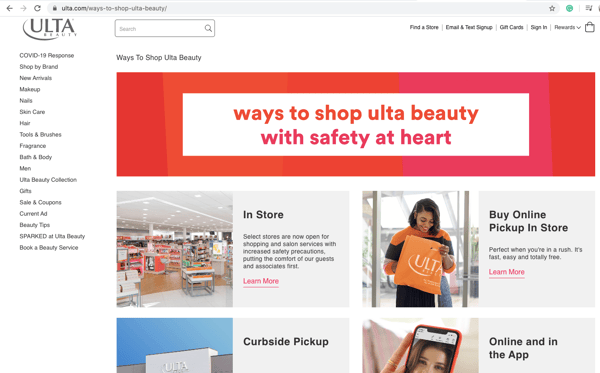
Urgent messages may come off as insensitive and ignorant to your consumers when they may be recovering from some of the devastating consequences of COVID-19 or similar emergency situations.
Some brands have taken the COVID-19 crisis as an opportunity to reposition their brands and have received favorable responses from consumers.
4 of the Best Marketing Strategy Examples in 2020
Many brands have developed marketing strategies and marketing messages during the uncertain times of 2020 that have made incredible impacts on the customers they serve. Here are some of the best marketing strategies businesses have applied that you can learn from:
Walgreens
Walgreens, one of the most successful pharmacies in the U.S., focused on helping their customers in many ways. They provided resources such as their Ask a Pharmacist series that provides informative videos to answer questions about COVID-19 that users may have.
They also changed their existing email campaign into a video to inform people about free prescription delivery and how to use online services for safety. Additionally, they offered drive-thru COVID-19 testing for first responders to demonstrate their commitment to serving their communities.
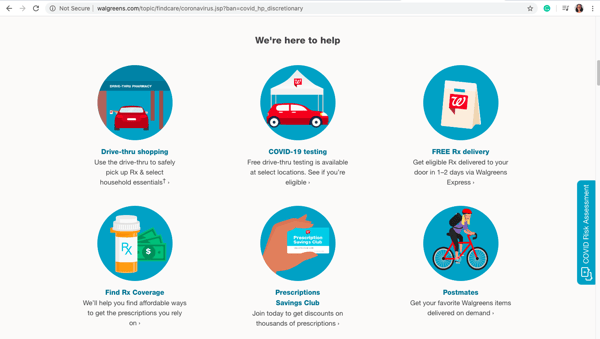
Carvana
Carvana allows people to purchase cars from the comfort of their home. They have a feature called Touchless Delivery that allows customers to have their car delivered without needing to have in-person interaction with the customer advocate who delivers the car to them.
Carvana also developed a payment extension option for those who were financially affected by COVID-19.
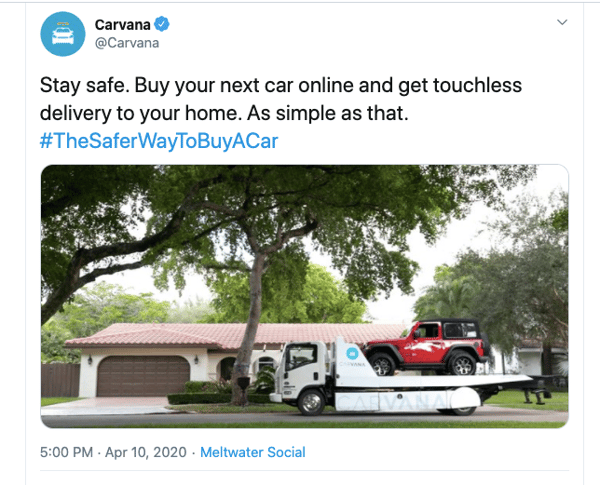
The pandemic forced a lot of people to conduct business and schooling from home. In response to this, Google announced that they would allow everyone, including schools and businesses, to take advantage of Google Meet, a video meeting app, for free until September.
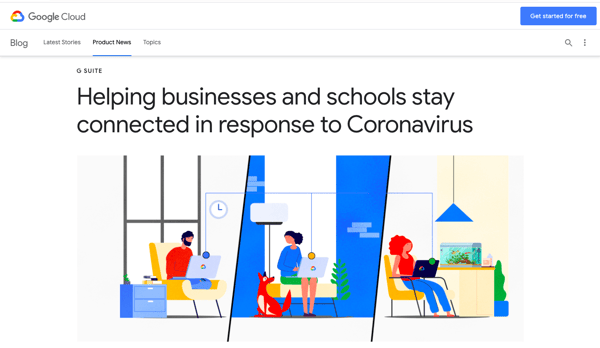
Ford
Ford evolved their advertising methods and conveyed their commitment to helping fight COVID-19 by starting to manufacture medical equipment that medical professionals needed due to a lack of supplies.
The new ads, “Built to Lend a Hand,” displayed Ford's care for their current customers by offering payment relief to those who lost jobs during the pandemic.
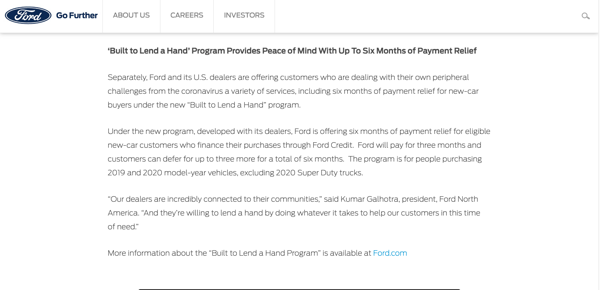
View the post-pandemic world as an opportunity to improve your marketing strategy to fuel business growth while highlighting your commitment to improving the lives of your customers.
You have the opportunity to position your brand as a socially responsible industry leader that continues to contribute to its customers in a meaningful way.
As you change your marketing strategy using these eight essential tips, you will reap the rewards and continue to delight both your new and existing customers.

Erika Giles
Erika is a Marketing Copywriter at Bluleadz. She is a huge fan of houseplants and podcasts about conspiracy theories. She spends most of her free time reading, writing, and enjoying the outdoors.